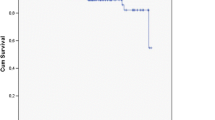Abstract
There are only few reports in literature about the treatment of traumatic lesions of the thoracic spine. They have been grouped together with thoracolumbar fractures, ignoring the particular biomechanics of the thoracic segment. The objective of this retrospective cohort is to describe the clinical presentation and outcomes of surgically treated patients with these injuries. Data were obtained from the institutional database of medical registries, identifying all the patients who had been treated for thoracic spine fractures, from January 1, 1995 through December 31, 2005 in our institution. The study group included the 51 surgically treated patients. General and surgery-related complications were considered as clinical outcomes and injury-related disability was also assessed. Statistical analysis evaluating possible associations with timing and type of surgery, neurological impairment and associated injuries was carried out. Motor vehicle accident was the most frequent mechanism of injury. Six patients had an incomplete neurological deficit, whereas 22 had a complete lesion. Thirty-two patients presented at least one complication. Five of the neurologically intact patients, while 20 of those with neurological impairment presented general complications (p = 0.0001). None of the patients’ neurological status deteriorated after surgery. All patients with complete spinal cord injury and those with incomplete cord injury with partial functional recovery received disability compensation. Short pedicle instrumentations should be used whenever possible, but also long instrumentations and mixed constructs may be necessary for the management of such unique fractures.


Similar content being viewed by others
References
El-Khoury GY, Whitten CG (1993) Trauma to the upper thoracic spine: anatomy, biomechanics, and unique imaging features. AJR Am J Roentgenol 160:95–102
Andriacchi T, Schultz A, Belytschko T et al (1974) A model for studies of mechanical interactions between the human spine and rib cage. J Biomech 7:497–507
Bohlman HH, Freehafer A, Dejak J (1985) The results of treatment of acute injuries of the upper thoracic spine with paralysis. J Bone Joint Surg Am 67:360–369
Schweighofer F, Hofer H, Wildburger R et al (1997) Unstable fractures of the upper thoracic spine. Langebecks Arch Chir 382:25–28
Yue J, Jossan A, Selgrath C et al (2002) The treatment of unstable thoracic spine fractures with transpedicular screw instrumentation. A 3-year consecutive series. Spine 27:2782–2787
Magerl F, Aebi M, Gertzbein S et al (1994) A comprehensive classification of thoracic and lumbar injuries. Eur Spine J 3:184–201
American Spine Injury Association (ASIA) International standards for neurological classification of SCI, Revised 2002 American Spine Injury Association Booklet
Coe J, Warden K, Herzig M et al (1990) Influence of bone mineral density on the fixation of thoracolumbar implants: a comparative study of transpedicular screws, laminar hooks and spinous process wires. Spine 15:902–907
Bracken M, Shepard M, Collins W et al (1999) A randomized, controlled trial of methylprednisolone or naloxone in the treatment of acute spinal cord injury. Results of the second national acute spinal cord injury study. N Eng J Med 20:1405–1411
Fehlings M, Perrin R (2006) The timing of surgical intervention in the treatment of spinal cord injury: a systematic review of recent clinical evidence. Spine 31:S28–S35
Yurac R, Marré B, Urzúa A et al (2006) Residual mobility of instrumented and non-fused segments in thoracolumbar spine fractures. Eur Spine J 15:864–875
Rowland JW, Hawryluk GW, Kwon B et al (2008) Current status of acute spinal cord injury pathophysiology and emerging therapies: promise on the horizon. Neurosurg Focus 25:E2–E18
Wuermser LA, Ho CH, Chiodo AE et al (2007) Spinal cord injury medicine. 2. Acute care management of traumatic and nontraumatic injury. Arch Phys Med Rehabil 88:S55–S61
McLain R, Burkus K, Benson D (2001) Segmental instrumentation for thoracic and thoracolumbar fractures: prospective analysis of construct survival and five-year follow-up. Spine J 1:310–323
Bransford R, Bellabarba C, Thompson J et al (2006) The safety of fluoroscopically assisted thoracic pedicle screw instrumentation for spine trauma. J Trauma 60:1047–1052
Potter BK, Lehman RA, Kuklo TR (2004) Anatomy and biomechanics of thoracic pedicle screw instrumentation. Curr Opin Orthop 15:133–141
Cotton B, Pryor J, Chinwalla I et al (2005) Respiratory complications and mortality risk associated with thoracic spine injury. J Trauma 6:1400–1409
McHenry T, Mirza S, Wang J et al (2006) Risk factors for respiratory failure following operative stabilization of thoracic and lumbar spine fractures. J Bone Joint Surg Am 88:997–1005
Brandt M, Wahl W, Yeom K et al (2004) Computed tomographic scanning reduces cost and time of complete spine evaluation. J Trauma 56:1022–1028
Antevil L, Sise M, Sack D et al (2006) Spiral computed tomography for the initial evaluation of spine trauma: a new standard of care? J Trauma 61:382–387
Van Beek E, Been H, Ponsen K, Maas M (2000) Upper thoracic spinal fractures in trauma patients—a diagnostic pitfall. Injury 31:219–223
Vialle L, Vialle E (2005) Thoracic spine fractures. Injury 36:S-B65–S-B72
Verlaan J, Diekerhof C, Buskens E et al (2004) Surgical treatment of traumatic fractures of the thoracic and lumbar spine. Spine 7:803–814
Goh S, Price R, Leedman p, Singer K (1999) The relative influence of vertebral body and inter-vertebral disc shape on thoracic kyphosis. Clin Biomech 14:439–448
IV WatkinsR, Williams L, Ahlbrand S et al (2005) Stability provided by the sternum and rib cage in the thoracic spine. Spine 1:1283–1286
Horton W, Kraiwattanapong C, Akamaru T et al (2005) The role of the sternum, costo-sternal articulations, intervertebral disc and facets in thoracic sagittal plane biomechanics. Spine 18:2014–2023
Feiertag M, Horton W, Norman J et al (1995) The effect of different surgical releases on thoracic spinal motion. Spine 20:1604–1611
McLain R (2004) Functional outcomes after surgery for spinal fractures: return to work and activity. Spine 4:470–477
Acknowledgments
The authors did not receive grants or outside founding support of their research or for preparation of this article.
Author information
Authors and Affiliations
Corresponding author
Rights and permissions
About this article
Cite this article
Marré, B., Ballesteros, V., Martínez, C. et al. Thoracic spine fractures: injury profile and outcomes of a surgically treated cohort. Eur Spine J 20, 1427–1433 (2011). https://doi.org/10.1007/s00586-011-1698-5
Received:
Revised:
Accepted:
Published:
Issue Date:
DOI: https://doi.org/10.1007/s00586-011-1698-5




